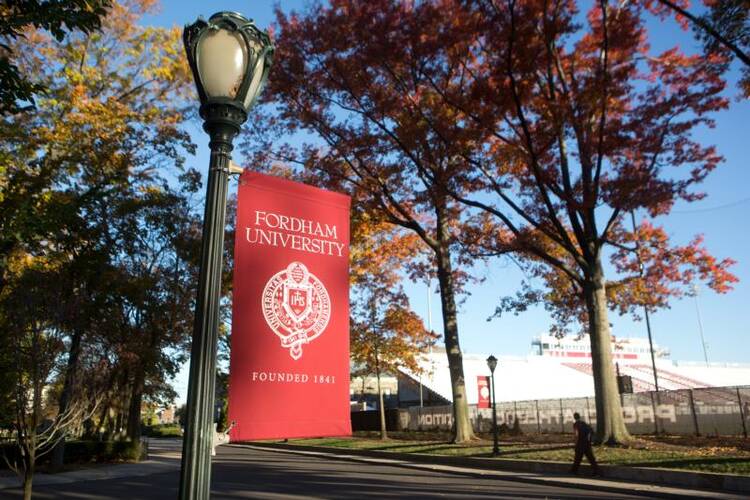Across the United States, where colleges and universities have closed for the academic year and ordered students to return home because of the Covid-19 pandemic, Catholic institutions are facing unique financial and pedagogical challenges.
Sweeping changes to U.S. life have occurred at breakneck speed while states mount individual responses to the coronavirus. Questions abound as to when restrictions on public gatherings may be lifted and how long social distancing must be practiced, obscuring the future of on-campus life for college students. Looking ahead to the next academic year, colleges are still unsure when they can reopen and how they can generate revenue as an economic recession looms.
The Rev. Dennis H. Holtschneider, president of the Association of Catholic Colleges and Universities, warns that many U.S. Catholic colleges will face financial hardships in the coming year and that “a handful” of these institutions may permanently close.
“This is a dire time for a lot of our organizations. There are universities that have great resources, but most Catholic universities have always educated the poor and run very thin margins.”
“This is a dire time for a lot of our organizations. There are universities that have great resources, but most Catholic universities have always educated the poor and run very thin margins,” he told America. These same schools are also an educational haven for many DACA students. Some 1,300 Catholic educators—including the Rev. Timothy P. Kesicki, S.J., president of the Jesuit Conference of Canada and the United States—asked President Trump in August 2017 to uphold the nation’s commitment to DACA students, the so-called Dreamers who entered the United States without documentation as children.
Father Holtschneider explained that to cut operating costs many Catholic colleges have furloughed staff members (while still providing health benefits), cut pay for senior staff, suspended some capital projects, created “austerity budgets,” and enacted hiring and wage freezes for the upcoming year. Sending students home for the remainder of the spring semester—and in many cases, refunding room-and-board payments—caused “a loss to the bottom line that put most schools in the red,” he said. Still, some Catholic institutions maintain large endowments from which they can pull funding if necessary.
In a university-wide email on May 5, the Rev. Joseph M. McShane, S.J., president of Fordham University, announced a projected revenue shortfall of nearly $100 million for fiscal year 2020. The revenue loss is, in part, tied to the university’s decision “to refund 50 percent of room, board and select student fees this spring.”
“Fordham is actively preparing to resume activities on campus this fall. Be assured that we will proceed in a manner that does not place any members of our community at undue risk.”
The email states that Fordham cannot use endowment funding to make up for revenue lost, as that funding is designated for scholarships and other programmatic purposes. Father McShane announced that the university expects to see a 12 percent decrease in enrollment in September from the previous fall semester.
“Fordham is actively preparing to resume activities on campus this fall. Be assured that we will proceed in a manner that does not place any members of our community at undue risk,” he wrote.
Kelvin Buck, a senior at Fordham from Portland, Ore., who uses they/them pronouns, discussed the challenges of remote learning and their uncertainty regarding the next academic year. “I’m unable to make a connection with my professors and my classmates or have a discussion without technical difficulties on someone’s end,” they wrote to America, explaining that the difference in time zone is an additional stressor.
“I can’t imagine starting online classes with professors I’m unfamiliar with, as opposed to professors I already had a dynamic with this semester. Many other seniors and I plan to complete our theses in the fall, which becomes much harder to do in our parents’ homes with few to none of the school’s resources at hand,” they wrote.
Fordham is not the only Catholic university faced with difficult financial decisions. Burdened by enrollment and fundraising issues exacerbated by the pandemic, Holy Family College in Manitowoc, Wis., announced on May 4 that it was closing its doors for good by the end of August.
Marquette University announced that it would enact temporary furloughs, reduce discretionary spending and establish a temporary hiring freeze.
Marquette University, the Jesuit institution in Milwaukee, announced last month that it would enact temporary furloughs affecting 250 employees after April 17. The university also reduced discretionary spending and established a temporary hiring freeze. “Our future financial health depends on the demand for online Summer Studies, our ability to virtually recruit next year’s incoming class and how Marquette and other private universities will benefit from a government stimulus package,” reads an email from university leadership.
Sacred Heart University in Fairfield, Conn., has also furloughed some employees effective May 1. John J. Petillo, president of Sacred Heart, told America that he has agreed to a 50 percent salary cut until the end of July. The university’s vice president and dean also took a 15 percent pay cut. Mr. Petillo’s total pay in 2017, according to data from The Chronicle of Higher Education, was $1,004,154. (His base pay was $491,082.)
“If there’s going to be hard times, those of us in leadership should take the first hit,” he said.
Deborah J. Noack, executive director of communications at Sacred Heart, told America that the university was one of the first to recall its students studying abroad amid coronavirus concerns. According to Mr. Petillo, Sacred Heart was the first university in Connecticut to switch to remote learning. As of this Monday, Sacred Heart is planning to resume in-person classes in the fall semester.
“We’ve ordered PPEs. We’ve got 20,000 or 30,000 masks so far. We have those electronic...temperature readers and we’re looking at other stuff. We bought 3,000 gallons of hand sanitizer that arrived [last] Thursday or Friday,” Mr. Petillo said. He predicts that large Catholic colleges with financial reserves, such as Boston College and the University of Notre Dame, will survive the economic fallout from coronavirus, but many schools with “thinner resources” will likely face closure.
Parents are also suffering during the current economic downturn. “We have lots and lots of parents who’ve lost their jobs and cannot pay tuition, so how do we make up for those tuition dollars?” asked Kathy Mears, interim president and C.E.O. of the National Catholic Educational Association, which primarily represents pre-K through 12 Catholic schools.
As at Fordham, other Catholic educational institutions are likely to see enrollment rates drop as fewer families can afford tuition next year. Father Holtschneider warned that if colleges must continue remote learning in the fall, they are likely to lose a portion of their incoming class. “[Colleges] already know they’re going to lose much of their international enrollment in the coming year,” he said, calling that loss “a significant hit.”
So what is the way forward for Catholic colleges? What might recovery look like? Father Holtschneider explained that most Catholic institutions are doing their best to survive on their own resources, hoping for an additional stimulus package from Congress and increased federal aid from the recently passed CARES Act. That legislation includes $339.8 billion for state and local government programs and $14 billion designated for higher education.
“We have lots and lots of parents who’ve lost their jobs and cannot pay tuition, so how do we make up for those tuition dollars?” asked Kathy Mears, interim president and C.E.O. of the National Catholic Educational Association,
While Father Holtschneider described the benefits enumerated in the CARES Act as “promising,” he said that very few Catholic colleges were initially eligible for Small Business Administration loans because of a requirement that student workers be counted as employees. Only companies with 500 or fewer employees qualify for the loans, and since many Catholic college students work on campus to pay for tuition, those schools are not considered small businesses.
But beginning on May 6, the S.B.A. will no longer count students receiving federal work-study funds toward the 500-employee limit. That may open up a new source of support for some colleges, according to Father Holtschneider.
For now, Catholic colleges are awaiting a decision on whether not-for-profit institutions can apply for loans through the Federal Reserve’s Main Street Lending Program. The Department of Education has made grants available as well, half of which are designated for students while the other half is intended to support the institutions. But the department issued guidelines that prohibited emergency funds from being used to assist DACA students—a call that drew criticism from congressional Democrats.
“The Department of Education has just released this week a whole series of requirements—that Congress did not introduce—that not only keep out the DACA students and the international students from getting aid, but because of the methodology they chose, actually eliminates a couple of million students in the United States from [obtaining aid],” said Father Holtschneider.
Mary Pat Donoghue, executive director of the Secretariat for Catholic Education for the U.S.C.C.B., said lessons learned by Catholic schools during the Great Recession can apply to today.
“We have a good number of schools facing a crisis because of Covid-19. Some of the things that worked very well when I headed up a school in crisis included strong communication between the school and community and the ability to articulate a compelling vision why we need Catholic schools,” she said.
Colleges must also adjust and adapt to the reality of sustained virtual education. “It’s a game changer,” said Gerald M. Cattaro, executive director of the Center for Catholic School Leadership and Faith-Based Education at Fordham University.
Mr. Cattaro called the recent pivot to remote learning a “big pedagogical shift” and believes schools ought to be flexible with their students, providing them increased time to complete assignments and offering a pass/fail option for courses. He is concerned, however, that remote learning does not recreate the community and spontaneity characteristic of face-to-face instruction. He stressed maintaining a commitment to the mission of Catholic schools—building community through pastoral work and various campus ministries.
For example, the University of Dayton has begun daily noon prayer meetings via Zoom, while Dominican University in River Forest, Ill., has initiated Caritas Now, a pastoral resource providing information on virtual church services in the Chicago area. Students at Caldwell University in New Jersey can discuss their faith life during online sessions of CU Faith Fridays.
“I think we have to have creativity, commitment, candor and community,” Mr. Cattaro told America.
On a more positive note, Ms. Mears is confident that relationships formed between students in Catholic schools will outlast this pandemic. Calling Catholic education “a true ministry of the church,” she maintains hope for its future and praises Catholic educators for their adroit switch to remote learning.
“The picture [of Catholic education] is going to be very different. That doesn’t make the picture bad,” she said.
Overall, schools will likely lose many international students as parents of Catholic college students also face job loss. Colleges will now face a quandry: how to generate more revenue as the economy declines and budgets are strapped for cash.
With reporting from Catholic News Service










